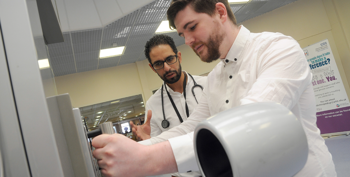Utilising technology to help prevent strokes and heart attacks
Monday, 10 July 2023

Roll out of Wellpoint Kiosks
Cardiovascular disease (CVD) is one of the leading causes of ill health, premature death and health inequalities in Cheshire and Merseyside. Initiatives to reduce CVD have been running in Cheshire and Merseyside for several years and a recent success has been the wider roll out of Wellpoint Kiosks.
Eight touch screen self-serve Wellpoint Kiosks, funded by ICS Transformation funding via the CVD Prevention Group, were placed in a range of community locations across areas of Cheshire and Merseyside with high levels of deprivation. Locations included leisure, retail and workplace settings, such as bus depots, in order to increase access to blood pressure testing in local priority populations.
The kiosks have been freely available to the public to measure blood pressure (BP), weight, body mass index (BMI) and other metrics. The kiosks also provide an estimate of risk of developing CVD, including heart attack and stroke in the next 10 years.
How does this improve population health?
The kiosks have performed extremely well across the subregion since September 2022, engaging 13,000 users and carrying out 15,000 tests, and 83% of users who engaged in feedback also reported that they were ‘very likely’ or ‘likely’ to modify their lifestyle following their results.
The evaluation clearly shows positive engagement from the public, including target communities such as working age males and those living in areas with high levels of deprivation, who are on average less likely to access CVD prevention services, but more likely to suffer with poorly controlled high blood pressure and early death from heart attack or stroke.
What’s next?
Our Cheshire and Merseyside Integrated Health and Care Partnership's CVD prevention group will now consider the findings to inform future kiosk use as part of the ‘Advancing CVD Prevention Strategy’.
Find out more
You can find out more about this work on the Champs Public Health Collaborative website.